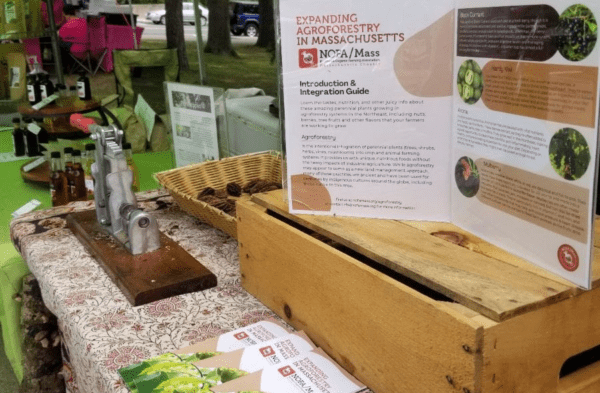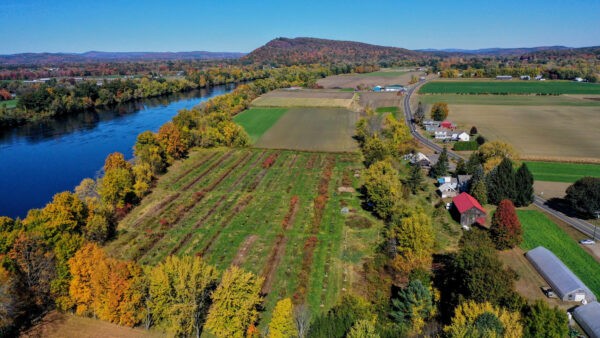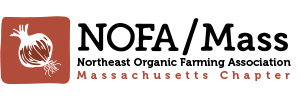By: Hannah McDonald, NOFA/Mass Education Events Coordinator

On a warm sunny Saturday in August, Gregory from Forestopia and I made our way to the Holyoke Farmers Market as a part of a series of events we are attending to talk to folks about Agroforestry in the Northeast. While our technical team supports our cohort of farmers with soil science and design leadership from Regenerative Design Group, Gregory and I speak with everyday people about the magic of integrated, diverse, perennial cropping systems that can help reestablish our forested landscapes in the Northeast, provide well-rounded nourishment, and utilize climate-smart farming practices.
Being at the Holyoke Farmers Market sheds a lot of light on the passion farmers have for serving their community; a diversity of foods, honey, and even personal care products & clothing are for sale (you know I went home with some freshly harvested beans and home-made sofrito!). The field of agroforestry is certainly dominated by white folks at this time. While the passion and knowledge is brewing there, it’s important that NOFA/Mass be present for the diversity of Massachusetts citizens. So not only did I get to take some sofrito home, but I was able to practice my Spanish too, and speak with folks about the benefits and opportunities within agroforestry systems.
Tabling with Gregory is a joy. We make a good team. He is a brave person, willing to carry products that most folks wouldn’t dare to sell, because a lot of people don’t know what they are. But he believes in it. A lot of people will pass by, overlooking our table, not having much of a relationship with chestnut flour or pecan oil. But in our kit, we carry the key: a nutcracker. ¿Le gustaría probar? Delicious, smooth butternuts, a cousin of the walnut. Very few people pass up the opportunity to crack a nut. We had trouble winning over some of the young kids after their visit to or from the donut stand next to us, but others were hooked, cracking multiple butternuts in a row. Some of the questions we heard most were: These grow here? How do I use them? Where do we find more?
Out of the woodwork came a diversity of people who were incredibly excited about these foods and practices, and understood the importance of returning our lands to being covered in trees. I left being incredibly inspired. An elder woman shared with me her many stories of foraging everywhere she goes throughout her life; children were nudging their parents for nutcrackers and mushroom logs; another woman browsed Gregory’s offerings and came up with recipes and sales ideas right on the spot. As much integration we know there is to do- from establishing these ecosystems, implementing infrastructure, developing markets, inspiring sovereignty and accessibility- not only do I have no doubt how viable this future is, but also how hungry we are for these growing practices and the culture that grounds and carries it all.
Another message that came through: the need to experience it, that it’s happening. If we want agroforestry as a viable practice and culture, we need to be as close to these environments as we can be. Maybe it means identifying and planting edible and useful trees around our neighborhoods as a great first step. When I moved into my house in Greenfield MA, I was surprised to find both a butternut and mulberry tree there to greet us, which makes me think, what other gems have been planted around me? Another way? To keep learning as much as we can, and visit the farms where it’s moving forward. NOFA/Mass is dedicated to making these connections and knows how critical it is in inspiring change.

In fact, you can join us at the Big River Chestnuts Farm Tour on Saturday, September 2nd from 1-4 pm, followed by a potluck. Big River Chestnuts is one of those places where you can feel the movement happening, and meet others who are just as excited about Agroforestry as you are.
On their way out of our tent, people would say Keep up the good work! I say…you too!





